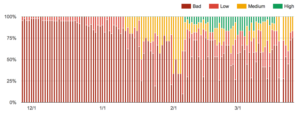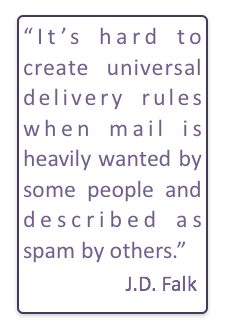IP Reputation
Dedicated IPs, pros and cons
There’s a whole belief system built around the idea that the best way to get good deliverability is to have your own dedicated IPs. In fact, senders regularly approach me to ask when is the right time for them to get a dedicated IP. They assume all their deliverability problems will disappear if they get a dedicated IP.
Read MoreHow long does it take to change reputation at Gmail?
Today I was chatting with a potential client who is in the middle of a frustrating warmup at Gmail. They’re doing absolutely the right things, it’s just taking longer than anyone wants. That’s kinda how it is with Gmail, while their algorithm can adapt quickly to changes. Sometimes, like when you’re warming up or trying to change a bad reputation, it can take 3 – 4 weeks to see any direct progress. This is a screenshot of IP reputation on Google Postmaster Tools. The sender made some significant changes in mail sending on some of their IP addresses starting in mid to late December. You can see, that the tools noticed and the reputation of those IPs bad to good fairly rapidly. It took a few more weeks of consistent sending for those two IPs to switch to yellow. And it took around another month for the reputation to flip to high.
This is a screenshot of IP reputation on Google Postmaster Tools. The sender made some significant changes in mail sending on some of their IP addresses starting in mid to late December. You can see, that the tools noticed and the reputation of those IPs bad to good fairly rapidly. It took a few more weeks of consistent sending for those two IPs to switch to yellow. And it took around another month for the reputation to flip to high.
Because this company is doing all the right things, and they’re seeing (as they describe it) some small amounts of improvement, I told them to give it another couple weeks. If they weren’t happy with their progress I could help them. But, frankly, until we can tell if this is something other than a normal warmup there isn’t much else to do.
When I got off the phone I felt very much like a doctor telling a patient to take two aspirin and call me in the morning. But, honestly, sometimes that is the right answer. Give it time.
What does good IP Reputation get you?
Today I was discussing some mailing list posts with an ESP colleague. He was telling me some interesting numbers he’d collected from different IP pools they maintain. He was testing routing mail through IPs based on subscription process and routing based on engagement metrics. The data showed that inboxing rates were similar across the test groups. As he put it, “IP reputation didn’t have much impact on inbox delivery.”
I’m not surprised. I’ve been talking for a while about how IP reputation is less important in reaching the inbox. In fact, it was almost 5 years ago now that I wrote The Death of IP Based Reputation. I updated it in 2015 with Deliverability and IP Reputation. Overall, IP reputation is a much smaller piece of reaching the inbox now than it has been in the past. I’ve talked about the reasons for this in the above posts. The short version is:
Filtering by gestalt
One of those $5.00 words I learned in the lab was gestalt. We were studying fetal alcohol syndrome (FAS) and, at the time, there were no consistent measurements or numbers that would drive a diagnosis of FAS. Diagnosis was by gestalt – that is by the patient looking like someone who had FAS.
It’s a funny word to say, it’s a funny word to hear. But it’s a useful term to describe the future of spam filtering. And I think we need to get used to thinking about filtering acting on more than just the individual parts of an email.
Filtering is not just IP reputation or domain reputation. It’s about the whole message. It’s mail from this IP with this authentication containing these URLs. Earlier this year, I wrote an article about Gmail filtering. The quote demonstrates the sum of the parts, but I didn’t really call it out at the time.
Why so many IP addresses?
Hi Laura,
Read More
Merry Xmas and wishing you a Happy New Year!
I recently looked at a popular ESP’s IPv4 space and I was astounded. How does an ESP get an IP allocation of 20,480 IPs? ARIN guidelines do not allow “MX/Mailing” IPs to count towards a valid justification especially in the case when each and every IP is being used for this purpose. That’s 80 /24’s…and at a time when we are out of IPv4 space….Would love to see a blog post with your insight about this issue….
When did the reject happen?
 Earlier today I approved a comment from Mike on a post about problems at AOL from 2012. The part of the comment that caught my attention:
Earlier today I approved a comment from Mike on a post about problems at AOL from 2012. The part of the comment that caught my attention:
Reputation is about behavior

Reputation is calculated based on actions. Send mail people want and like and interact with and get a good reputation. Send mail people don’t want and don’t like and don’t interact with and get a bad reputation.
Reputation is not
… about who the sender is.
… about legitimacy.
… about speech.
… about message.
Reputation is
… about sender behavior.
… about recipient behavior.
… about how wanted a particular mail is forecast to be.
… based on facts.
Reputation isn’t really that complicated, but there are a lot of different beliefs about reputation that seem to make it complicated.
The reputation of a sender can be different at different receivers.
Senders sometimes target domains differently. That means one receiver may see acceptable behavior but another receiver may see a completely different behavior.
Receivers sometimes have different standards. These include standards for what bad behavior is and how it is measured. They may also have different thresholds for things like complaints and bounces.
What this means is that delivery at one receiver has no impact on delivery at another. Just because ISP A delivers a particular mail to the inbox doesn’t mean that ISP B will accept the same mail. Each receiver has their own standards and sometimes senders need to tune mail for a specific receiver. One of my clients, for instance, tunes engagement filters based on the webmail domain in the email address. Webmail domain A needs a different level of engagement than webmail domain B.
Public reputation measures are based on data feeds.
There are multiple public sources where senders can check their reputation. Most of these sources depend on data feeds from receiver partners. Sometimes they curate and maintain their own data sources, often in the form of spamtrap feeds. But these public sources are only as good as their data analysis. Sometimes, they can show a good reputation where there isn’t one, or a bad reputation where there isn’t one.
Email reputation is composed of lots of different reputations.
Email reputation determines delivery. Getting to the inbox doesn’t mean sending from an IP with a good reputation. IP reputation is combined with domain reputation and content reputation to get the email reputation. IP reputation is often treated as the only valuable reputation because of the prevalence of IP based blocking. But there are SMTP level blocks against domains as well, often for phishing or virus links. Good IP reputation is necessary but not sufficient for good email delivery.
Reputation is about what a sender does, not about who a sender is.
Just because a company is a household name doesn’t mean their practices are good enough to make it to the inbox. Email is a meritocracy. Send mail that merits the inbox and it will get to recipients. Send email that doesn’t, and suffer the repercussions.
Deliverability and IP addresses
Almost 2 years ago I wrote a blog post titled The Death of IP Based Reputation. These days I’m even more sure that IP based reputation is well and truly dead for legitimate senders.
There are a lot of reasons for this continued change. 
Dodging filters makes for effective spamming
Spam is still 80 – 90% of global email volume, depending on which study look at. Most of that spam doesn’t make it to the inbox; ISPs reject a lot of it during the SMTP transaction and put much of rest of it in the bulk folder. But as the volumes of spam have grown, ISPs and filters are relying more and more on automation. Gone are the days when a team of people could manually review spam and tune filters. There’s just too much of it out there for it to be cost effective to manually review filters.
In some ways, though, automatic filters are easier to avoid than manual filters. Take a spam that I received at multiple addresses today. It’s an advertisement for lists to “meet my marketing needs.” I started out looking at this mail to walk readers through all of the reasons I distrusted this mail. But some testing, the same sorts of testing I do for client mails, told me that this mail was making it to the inbox at major ISPs.
What told me this mail was spam? Let’s look at the evidence.
IP reputation and email delivery
IP reputation is a measure of how much wanted mail a particular IP address sends. This wanted mail is measured as a portion of the total email sent from that IP. Initially IP reputation was really the be all and end all of reputation, there was no real good way to authenticate a domain or a from address. Many ISPs built complex IP reputation models to evaluate mail based on the IP that sent the mail.
These IP reputation models were the best we had, but there were a lot of ways for spammers to game the system. Some spammers would create lots of accounts at ISPs and use them to open and interact with mail. Other spammers would trickle their mail out over hundreds or thousands of IPs in the hopes of diluting the badness enough to get to the inbox. Through it all they kept trying to get mail out through reputable ESPs, either by posing as legitimate customers or compromising servers.
These things worked for a while, but the ISPs started looking harder at the recipient pool in order to figure out if the interactions were real or not. They started looking at the total amount of identical mail coming from multiple IP addresses. The ISPs couldn’t rely on IP reputation so they started to dig down and get into content based filtering.
As the ISPs got better at identifying content and filtering on factors other than source IP, the importance of the IP address on inbox delivery changed. No longer was it good enough to have a high reputation IP sending mail.
These days your IP reputation dictates how fast you can send mail to a particular ISP. But a high reputation IP isn’t sufficient to get all the mail in the inbox. It’s really content that drives the inbox / bulk folder decisions these days.
Generally IPs that the ISP has not seen email traffic from before start out with a slight negative reputation. This is because most new IPs are actually infected machines. The negative reputation translates to rate limiting. The rate limiting minimizes people getting spam while the ISP works out if this is a real sender or a spammer.
Some ISPs put mail in the inbox and bulk foldering during the whitelisting process. In this case what they’re doing is seeing if your recipients care enough about your mail to look for it in the bulk folder. If they do, and they mark the mail as “not spam” then this feeds back to the sender reputation and the IP reputation.
If you’re seeing a lot of bulk foldering of mail, it’s unlikely there’s anything IP reputation based to do. Instead of worrying about IP reputation, focus instead on the content of the mail and see what you may need to do to improve the reputation of the domains and URLs (or landing pages) in the emails.
Domains need to be warmed, too
One thing that came out of the ISP session at M3AAWG is that domains need to be warmed up, too. I can’t remember exactly which ISP rep said it, but there was general nodding across the panel when this was said.
This isn’t just the domain in the reverse DNS of the sending IP, but also domains used in the Return Path (Envelope From) and visible from.
From the ISP’s perspective, this makes tons of sense. Some of the most prolific snowshoe spammers use new domains and new IPs for every send. They’re not trying to establish a reputation, rather they’re trying to avoid one. ISPs respond by distrusting any mail from a new IP with a new domain.
The death of IP based reputation
Back in the dark ages of email delivery the only thing that really mattered to get your email into the inbox was having a good IP reputation. If your IP sent good mail most of the time, then that mail got into the inbox and all was well with the world. All that mattered was that good IP reputation. Even better for the people who wanted to game the system and get their spam into the inbox, there were many ways to get around IP reputation.
Every time the ISPs and spam filtering companies would work out a way to block spam using IP addresses, spammers would figure out a way around the problem. ISPs started blocking IPs so spammers moved to open relays. Filters started blocking open relays, so spammers moved to open proxies. Filters started blocking mail open proxies so spammers created botnets. Filters started blocking botnets, so spammers started stealing IP reputation by compromising ESP and ISP user accounts. Filters were constantly playing catchup with the next new method of getting a good IP reputation, while still sending spam.
While spammers were adapting and subverting IP based filtering a number of other things were happening. Many smart people in the email space were looking at improving authentication technology. SPF was the beginning, but problems with SPF led to Domains Keys and DKIM. Now we’re even seeing protocols (DMARC) layered on top of DKIM. Additionally, the price of data storage and processing got cheaper and data mining software got better.
The improvement in processing power, data mining and data storage made it actually feasible for ISPs and filtering companies to analyze content at standard email delivery speeds. Since all IPv4 addresses are now allocated, most companies are planning for mail services to migrate to IPv6. There are too many IPv6 IPss to rely on IP reputation for delivery decisions.
What this means is that in the modern email filtering system, IPs are only a portion of the information filters look at when making delivery decisions. Now, filters look at the overall content of the email, including images and URLs. Many filters are even following URLs to confirm the landing pages aren’t hosting malicious software, or isn’t content that’s been blocked before. Some filters are looking at DNS entries like nameservers and seeing if those nameservers are associated with bad mail. That’s even before we get to the user feedback, in the form of “this is spam” or “this is not spam” clicks, which now seem to affect both content, domain and IP reputation.
I don’t expect IP reputation to become a complete non-issue. I think it’s still valuable data for ISPs and filters to evaluate as part of the delivery decision process. That being said, IP reputation is so much less a guiding factor in good email delivery than it was 3 or 4 years ago. Just having an IP with a great reputation is not sufficient for inbox delivery. You have to have a good IP reputation and good content and good URLs.
Anyone who wants good email delivery should consider their IP reputation, but only as one piece of the delivery strategy. Focusing on a great IP reputation will not guarantee good inbox delivery. Look at the whole program, not just a small part of it.
Is Amazon SES a reputable place to send mail from
On the first installment of our Wednesday question series, I chose a question from twitter.
Read MoreDelivery challenges increasing
Return Path published their most recent Global Deliverability report this morning. (Get the Report) This shows that inbox placement of mail has decreased 6% in the second half of 2011. This decrease is the largest decrease Return Path has seen in their years of doing this report.
To be honest, I’m not surprised at the decrease. Filters are getting more sophisticated. This means they’re not relying on simply IP reputation for inbox delivery any longer. IP reputation gets mail through the SMTP transaction, but after that mail is subject to content filters. Those content filters are getting a lot better at sorting out “wanted” from “unwanted” mail.
I’m also hearing a lot of anecdotal reports that bulk folder placements at a couple large ISPs increased in the first quarter of 2012. This is after the RP study was finished, and tells me increased bulk folder placement is more likely to be a trend and not a blip.
One of the other interesting things from the RP study is that the differences are not across all mail streams, but are concentrated in certain streams and they vary across different regions.
IP Address reputation primer
There has been a lot of recent discussion and questions about reputation, content and delivery. I started to answer some of them, and then realized there weren’t any basic reference documents I could refer to when explaining the interaction. So I decided to write some.
This first post is about IP address reputation with some background on why IPs are so important and why ISPs focus so heavily on the sending IP.
